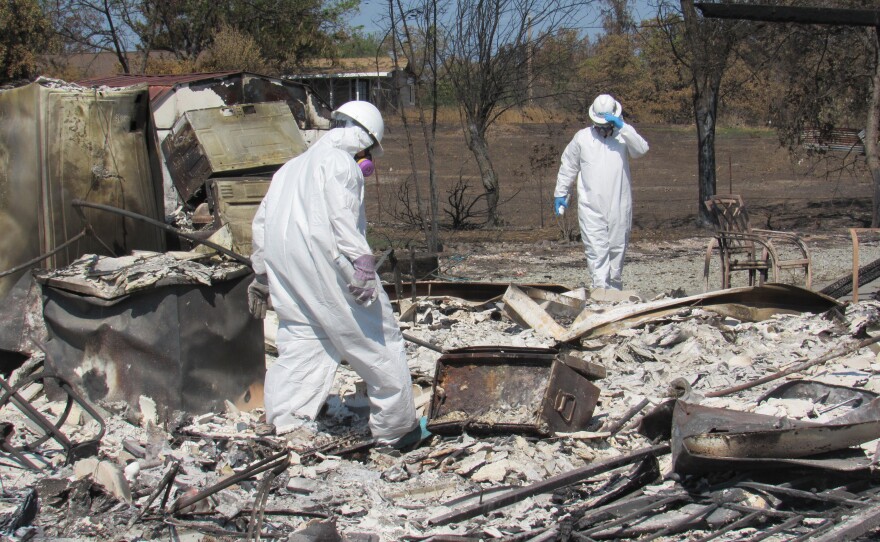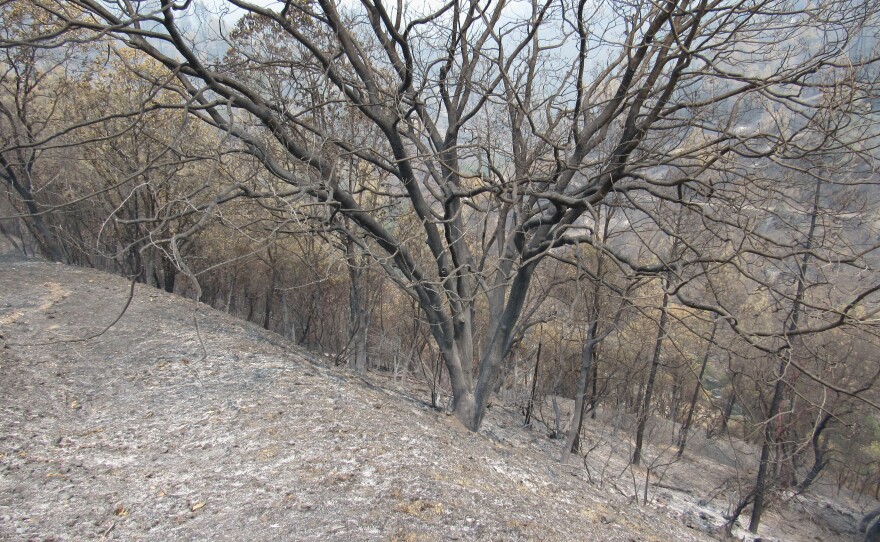In late July, the Carr fire swept through parts of Redding, California and the surrounding area. Now, residents are faced with burned hillsides and more than a thousand home sites contaminated with toxic ash. What are the potential environmental impacts? JPR’s Liam Moriarty went to find out.
I’m just off Keswick Dam Road on the western edge of Redding. The Carr fire blasted through this neighborhood on the evening of July 26, incinerating dozens of homes. Now, a crew in white haz-mat suits and respirators is methodically sifting through the ash and rubble. Ivan Rodriguez, with the California Department of Toxic Substances Control, says this is Phase One of the cleanup.
“That entails screening the properties that have been devastated by the fire, and looking at household hazardous waste that needs to be removed to allow for the ash and debris to go off at a future time,” he explains.
Rodriguez says the typical American home contains a whole range of products that can cause toxic contamination after a fire.
“We’re looking for compressed gas cylinders, we’re looking for batteries, Looking for any paints, any solvents, any pesticides, herbicides. If they had a pool you’ve got chlorine, you’ve got acids … “
The haz-mat workers are marking what they find with spray paint to signal the removal crews; white paint for propane tanks and other standard hazardous wastes, pink for asbestos, which requires its own special removal techniques. Once Phase One is complete, crews will collect the ash and rubble – including the building’s foundation – and haul it off to a hazardous waste facility.
The danger of toxic ash blowing across the landscape gives this job a sense of urgency. But there are other post-fire threats, as well …
Daniel Whitley is standing on the deck behind of his home in the Lake Redding Estates neighborhood, where many homes were damaged or destroyed. Whitley’s was nearly one of them.
“We’re looking at the remnants of the Carr fire that came perilously close to the back of the house,” he says.
As he points to the burned hillside right out his back door, he talks about his plans to head off the erosion that winter rains are likely to cause.
“I’ll put in some straw wattles, those long, straw-filled flexible things,” he says. “And then I’m going to plant some perennial bunchgrasses up there.”
Whitley says if he can get the grasses established before winter, he thinks he can avoid potential mudslides.
Drew Coe says that in some of Redding’s burned-over hillside neighborhoods, so-called “debris flows” could well be a danger.
“You can have essentially a large mass of rock and mud and water moving down, and it can wipe out a house,” he says.
Coe is with CalFire’s Watershed Emergency Response Team. The group of hydrologists, soil scientists and other experts uses sophisticated digital mapping tools – and on-site observation – to identify populated areas at risk for landslides and other post-fire hazards to safety and property. He says the size of the Carr fire – and the geological conditions in Redding – mean the threats here aren’t as dire as after last year’s massive Thomas fire in southern California.
“They are numerous,” he says. “But we don’t have large concentrations of populations just downstream of watersheds that can respond in a high-magnitude way to storms following wildfire. We don’t have a Montecito here.”
Montecito, near Santa Barbara, was hit with monster mudslides last January, when heavy rains fell on burned-over hillsides. Nearly two dozen people died.
But Tricia Bratcher, a biologist with the California Department of Fish and Wildlife, says risks to people and their homes aren’t the only erosion concern …
“We are looking at Upper Clear Creek. And across from us is actually one of our restoration projects,” she says.
Bratcher says her agency and others have spent a lot of time, effort and money restoring this creek so salmon and other threatened fish can recover. Now, she and her colleagues are worried the post-fire hillsides, denuded of vegetation, could undo some of those gains by allowing ash and fine sediment to wash into the creek and clog up the nests where salmon lay their eggs.
“You need water moving through that nest to bring in dissolved oxygen,” she says. “And if it’s full of sand and fines, it smothers the eggs and they die.”
Clint Snyder, with the Regional Water Quality Control Board, adds that ash from burned homes often contains heavy metals and other toxins. And, he says …
“As those metals move into the stream systems, then we have the potential to further impact salmonids and other organisms from a toxicity standpoint.”
Snyder says efforts to prevent erosion into those streams is crucial to minimizing the harm that sediment and toxins could do to fish.
Right now, the clock is ticking, and efforts to get hillsides stabilized and contaminated sites cleaned up are in full swing. How soon winter rains arrive – and how heavily they fall -- will go a long way toward determining how much damage the Carr fire continues to cause, long after the flames are doused.









